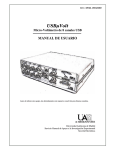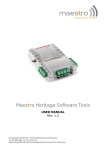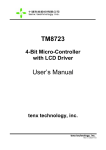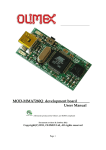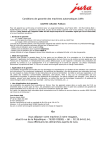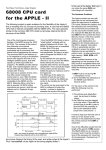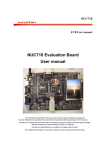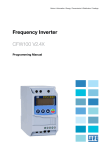Download User`s manual for the hcAT91 CPU card in PDF format
Transcript
hcAT91 CPU card User Manual Revision: 1.0 © 2004 Andras Tantos and Modular Circuits. All rights reserved. Introduction The hcAT91 CPU card is a member of the H-Storm system CPU card family. The H-Storm project is a modular system-level design approach targeting hobby electronics, robotics and fast prototyping. The project defines a standard 72-pin connector as the interconnect between the various elements of the system with two optional 20pin extension connectors. The elements of an H-Storm system are CPU cards, peripherial cards and systemboards. For detailed information on the H-Storm project please see the H-Storm System Manual available from the H-Storm website. The hcAT91 CPU card is a standard H-Storm system component and is built around the ATMEL AT91R40008 microcontroller. That device integrates a 66MHz ARM7TDMI processor core with 256kBytes of on-chip SRAM and a wide set of peripherials. The processor employs a 32-bit internal and a 16-bit external bus architecture. The CPU card combines this microcontroller with a 16-bit FLASH ROM of up to 8MByte in size, and some support circuitry. The low power microcontroller is run on 1.8V core and 3.3V I/O power supply voltages. The core power can be produced on-board by a small LDO regulator or provided externally. The processor module can be programmed in a variety of languages using the GNU toolchain, like C/C++ Pascal or ADA. There are also several other commercial development tools available from many vendors. © 2004 Andras Tantos, Modular Circuits Rev: 1.0 hcAT91 CPU card User Manual Table of Contents Introduction..............................................................................................................................................................2 Features.................................................................................................................................................................... 3 License..................................................................................................................................................................... 3 H-Storm Non-Commercial license (HSNCL)..................................................................................................... 3 Theory of operation..................................................................................................................................................4 System-bus.......................................................................................................................................................... 4 Integrated peripherials......................................................................................................................................... 5 PnP Bus............................................................................................................................................................... 6 Programming mode............................................................................................................................................. 6 Power considerations...........................................................................................................................................6 H-Storm module connector pin-out......................................................................................................................... 7 Mechanical design....................................................................................................................................................7 Electrical design.......................................................................................................................................................7 Features • • • • • • • • • • • • • • 66MHz ARM7TDMI processor core 256kb zero wait-state RAM Up to 8MBytes of 16-bit FLASH memory (2MB standard) A user-programmable LED to display program state A watch-dog LED that lights up if a watch-dog event occurred Optional internal core power supply 8-bit or 16-bit external bus operations are supported Versatile bus-interface with programmable speed for each different peripherial slot Two serial ports Three timer/counters Up-to 22 digital I/O lines (27 in non-H-Storm compatible mode) JTAG debug interface provided Can boot from internal FLASH or from external memory connected to nSEL0 On-board reset generator License This document and all the accompanying design documentation (for example schematic and PCB files) are covered by the H-Storm Non-Commercial License (HSNCL). HSNCL H-Storm Non-Commercial license (HSNCL) HSNCL Copyright 2004 Andras Tantos and Modular Circuits. All rights reserved. Redistribution and use in source or binary forms, or incorporated into a physical (hardware) product, with or without modification, are permitted for non-commercial use only, provided that the following conditions are met: • The redistribution doesn't result in financial gain. • Redistributions of source code must retain the above copyright notice, this list of conditions and the following disclaimer. 3 License hcAT91 CPU card User Manual Rev: 1.0 © 2004 Andras Tantos, Modular Circuits Redistributions in any other form must contain in printed or electronical format the above copyright notice, this list of conditions and the following disclaimer in the documentation and/or other materials provided with the distribution. • All advertising materials mentioning features or use of this technology must display the following acknowledgment: This product includes H-Storm technology developed by Andras Tantos and Modular Circuits. • Neither the name of Andras Tantos or Modular Circuits may be used to endorse or promote products derived from or using this technology without specific prior written permission. ALL THE INFORMATION, TECHNOLOGY, AND SOFTWARE IS PROVIDED BY THE AUTHORS ``AS IS'' AND ANY EXPRESS OR IMPLIED WARRANTIES, INCLUDING, BUT NOT LIMITED TO, THE IMPLIED WARRANTIES OF MERCHANTABILITY AND FITNESS FOR A PARTICULAR PURPOSE ARE DISCLAIMED. IN NO EVENT SHALL ANDRAS TANTOS, MODULAR CIRCUITS OR CONTRIBUTORS BE LIABLE FOR ANY DIRECT, INDIRECT, INCIDENTAL, SPECIAL, EXEMPLARY, OR CONSEQUENTIAL DAMAGES (INCLUDING, BUT NOT LIMITED TO, PROCUREMENT OF SUBSTITUTE GOODS OR SERVICES; LOSS OF USE, DATA, OR PROFITS; OR BUSINESS INTERRUPTION) HOWEVER CAUSED AND ON ANY THEORY OF LIABILITY, WHETHER IN CONTRACT, STRICT LIABILITY, OR TORT (INCLUDING NEGLIGENCE OR OTHERWISE) ARISING IN ANY WAY OUT OF THE USE OF THIS SOFTWARE OR TECHNOLOGY, EVEN IF ADVISED OF THE POSSIBILITY OF SUCH DAMAGE. • Theory of operation The hcAT91 module contains three main components and some additional support circuitry. The tree main components are the AT91R40008 microcontroller, the 16-bit FLASH memory and the 72-pin H-Storm standard connector. System-bus The integrated memory-controller of the microcontroller is used to address the three available peripherial regions (nSEL0, nSEL1, nSEL2) and the FLASH memory. All I/O regions are mapped to memory locations. The mapping between these signals and the microcontrollers' external chip-selects under normal operation is as follows: H-Storm signal AT91R40008 signal FLASH memory CS0 nSEL0 CS1 nSEL1 CS2 nSEL2 CS3 When the module is in programming mode (nPROG is low), the previous assignment is modified as follows: H-Storm signal AT91R40008 signal nSEL0 CS0 nSEL0 CS1 nSEL1 CS2 nSEL2 CS3 Theory of operation 4 © 2004 Andras Tantos, Modular Circuits Rev: 1.0 hcAT91 CPU card User Manual Since the microcontroller boots from external memory connected to CS0, this change makes it possible to boot the processor from either the internal FLASH memory for normal operation or from an external memory connected to nSEL0 for initial programming purposes. Upon reset the microcontroller starts execution of the program found in a memory connected to CS0. This memory is initially mapped to physical address 0. The execution starts in ARM mode. The memory access cycles are programmed to be rather slow so that all types of FLASH devices would be compatible with the processor. After the initial program startup, the application can program faster accesses to CS0 to better match the capabilities of the FLASH memory, switch to THUMB mode to better facilitate the narrow 16-bit external bus, or copy itself into internal RAM where it can be executed full-speed with zero wait-states. Additional chip-select signals (CS1-CS3) are used to access the H-Storm peripherial and the system-board. These chip-select signals can be assigned to arbitrary physical memory locations to better suite the application needs and are highly programmable so that various communication speeds can be used with different peripherials. The CPU module supports both 8-bit and 16-bit access cycles, with and without wait-states. It does not generate burst cycles. The module support both edge- and level-triggered interrupts. The nIRQx lines of the H-Storm connector are connected to IRQ lines of the microcontroller as follows: H-Storm signal AT91R40008 signal nIRQ0 FIQ nIRQ1 IRQ1 nIRQ2 IRQ2 Integrated peripherials The microcontroller contains three timers/counters, two serial ports, a watch-dog timer and 32-bit GPIO lines. Many of these lines however are multiplexed to the same pins of the processor chip. All of the available peripherials are connected to the H-Storm bus, with the exception of a couple of the GPIO lines. The userdefined part of the H-Storm connector is connected to the microcontroller pins as follows: H-Storm signal AT91R40008 signal IOA0 P13/SCK0 IOA1 none IOA2 P15/RXD0 IOA3 P13/SCK0 IOA4 none IOA5 P14/TXD0 IOB0 P20/SCK1 IOB1 none IOB2 P22/RXD1 IOB3 P20/SCK1 IOB4 none IOB5 P21/TXD1 5 Theory of operation hcAT91 CPU card User Manual H-Storm signal Rev: 1.0 © 2004 Andras Tantos, Modular Circuits AT91R40008 signal IOC0 P0/TCLK0 IOC1 P1/TIOA0 IOC2 P2/TIOB0 IOC3 P3/TCLK1 IOC4 P4/TIOA1 IOC5 P5/TIOB1 IOD0 P6/TCLK2 IOD1 P7/TIOA2 IOD2 P8/TIOB2 IOD3 P9/IRQ0 IOD4 P16 IOD5 P17 IOD6 P18 IOD7 P19 PnP Bus The H-Storm PnP bus signals are connected to two GPIO lines of the microcontroller. The protocol of the PnP bus is implemented in SW. The pin assignment is as follows: H-Storm signal AT91R40008 signal PnP_C P23 PnP_D P31 Programming mode When the nPROG signal is tied low upon reset, the microcontroller will boot from an external memory connected to nSEL0 for initial programming purposes. This allows for program execution on a module where the on-board flash is corrupted or simply blank. The external memory can contain code that erases and reprograms the FLASH memory such that consequent boot attempts from that memory would succeed. Since the standard H-Storm bus is capable of accessing only 2kBytes of external memory connected to any single peripherial select signal, only a very small boot-loader program can be placed in that external memory. The usual method therefore would be that that small boot-loader would download a bigger binary image from a host computer by means of one of the serial ports of the microcontroller. This larger program would than be capable of initializing the FLASH memory to a valid state and program a boot-image into it. When the nPROG signal is high upon reset, normal boot-sequence from the on-board FLASH memory us used. Power considerations Two versions of the module exist. One contains an integrated 1.8V voltage regulator and requires only a single power source of 3.3V. The other does not contain this integrated power supply and relies on dual 3.3V/1.8V external power. The power consumption of the module under various circumstances is as follows: Theory of operation 6 © 2004 Andras Tantos, Modular Circuits Condition Rev: 1.0 hcAT91 CPU card User Manual Power consumption single power version dual power version 3.3V 3.3V 1.8V Power down TBD TBD TBD Idle TBD TBD TBD Normal 55mA TBD TBD Peak TBD TBD TBD H-Storm module connector pin-out Pin number Pin function Pin name Note A1 O nRD Active low read enable A2 O nUWE Active low upper byte write enable A3 O nLWE Active low lower byte write enable A4 IOCPU nRESET Active low reset input/output A5 O nESEL0 Active low external module select 0 A6 O nESEL1 Active low external module select 1 A7 O nESEL2 Active low external module select 2 A8 IPU nFIRQ Active low fast-interrupt request input A9 IPU nIRQ1 Active low interrupt request input A10 IPU nIRQ2 Active low interrupt request input A11 IPU nWAIT Active low external wait-state input A12 IPU nPROG Active low programming mode select A13 O A0 Address lines A14 O A1 A15 O A2 A16 O A3 A17 O A4 A18 O A5 A19 O A6 A20 O A7 A21 O A8 A22 O A9 7 H-Storm module connector pin-out hcAT91 CPU card User Manual Pin number Pin function Pin name A23 IO D0 A24 IO D1 A25 IO D2 A26 IO D3 A27 IO D4 A28 IO D5 A29 IO D6 A30 IO D7 A31 IO D8 A32 IO D9 A33 IO D10 A34 IO D11 A35 IO D12 A36 IO D13 A37 IO D14 A38 IO D15 A39 PWR VCC A40 PWR VCC A41 PWR GND A42 PWR GND A43 PWR VCC_1_8 A44 A45 Rev: 1.0 © 2004 Andras Tantos, Modular Circuits Note Data lines 3.3V power supply Ground power line 1.8V power supply or n.c. if the CPU card is single supply n.c. IO A46 P13/SCK0 General purpose I/O line, serial port 0 clock none A47 IO P15/RXD0 General purpose I/O line, serial port 0 data transmit line A48 IO P13/SCK0 General purpose I/O line, serial port 0 clock A49 none A50 IO P14/TXD0 General purpose I/O line, serial port 0 data receive line A51 IO P20/SCK1 General purpose I/O line, serial port 1 clock A52 none A53 IO P22/RXD1 General purpose I/O line, serial port 1 data transmit line A54 IO P20/SCK1 General purpose I/O line, serial port 1 clock A55 none H-Storm module connector pin-out 8 © 2004 Andras Tantos, Modular Circuits Pin number Pin function Rev: 1.0 Pin name hcAT91 CPU card User Manual Note A56 IO P21/TXD1 General purpose I/O line, serial port 1 data receive line A57 IO P0/TCLK0 General purpose I/O line, timer 0 clock A58 IO P1/TIOA0 General purpose I/O line, timer 0 I/O A A59 IO P2/TIOB0 General purpose I/O line, timer 0 I/O D A60 IO P3/TCLK1 General purpose I/O line, timer 1 clock A61 IO P4/TIOA1 General purpose I/O line, timer 1 I/O A A62 IO P5/TIOB1 General purpose I/O line, timer 1 I/O D A63 IO P6/TCLK2 General purpose I/O line, timer 2 clock A64 IO P7/TIOA2 General purpose I/O line, timer 2 I/O A A65 IO P8/TIOB2 General purpose I/O line, timer 2 I/O D A66 IO P9/IRQ0 General purpose I/O line, interrupt signal 0 A67 IO P16 General purpose I/O line A68 IO P17 General purpose I/O line A69 IO P18 General purpose I/O line A70 IO P19 General purpose I/O line A71 IOPU PnP_C/P23 Plug-and-play bus clock signal, General purpose I/O line A72 IOPU PnP_D/P31 Plug-and-play bus data signal, General purpose I/O line Mechanical design The module adheres to the H-Storm standard module specification. It is 100mm wide and 47.5mm high. It is implemented on a standard double-sided 1.5mm laminate PCB process with 0.5mm via hole size and 0.2mm track width. 9 Mechanical design









